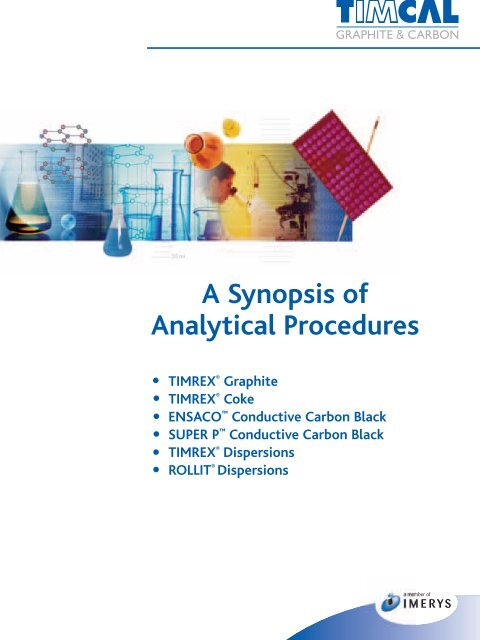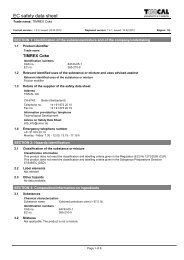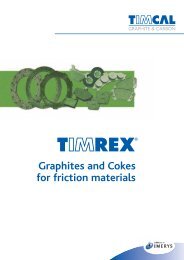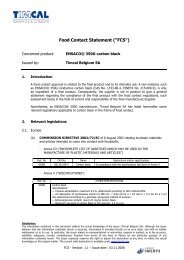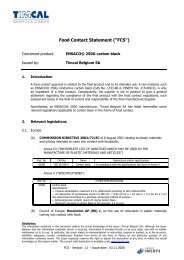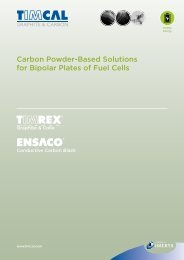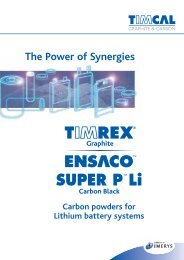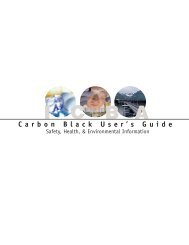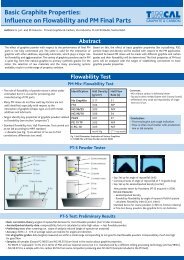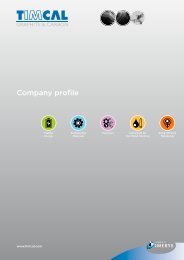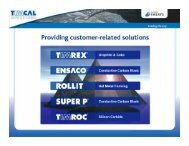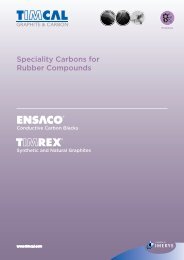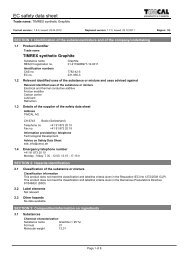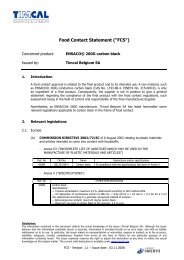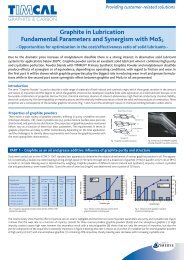Brochure: A Synopsis of Analytical Procedures - Timcal
Brochure: A Synopsis of Analytical Procedures - Timcal
Brochure: A Synopsis of Analytical Procedures - Timcal
You also want an ePaper? Increase the reach of your titles
YUMPU automatically turns print PDFs into web optimized ePapers that Google loves.
A <strong>Synopsis</strong> <strong>of</strong><strong>Analytical</strong> <strong>Procedures</strong>TIMREX ® GraphiteTIMREX ® CokeENSACO Conductive Carbon BlackSUPER P Conductive Carbon BlackTIMREX ® DispersionsROLLIT ® Dispersions
www.timcal.comWho are we?NTIMCAL Graphite & Carbon has a strongtradition and history in carbon manufacturing.Its first manufacturing operation wasfounded in 1908.NToday, TIMCAL facilities produce andmarket a large variety <strong>of</strong> synthetic and naturalgraphite powders, conductive carbonblack and dispersions <strong>of</strong> consistent highquality.NAdhering to a philosophy <strong>of</strong> Total QualityManagement and continuous processimprovement, the TIMCAL manufacturingplants comply with ISO 9001-2000.NTIMCAL Graphite & Carbon is committedto produce highly specialized graphiteand carbon materials for today’s and tomorrow’scustomers needs.NTIMCAL Graphite & Carbon is a member<strong>of</strong> IMERYS, a world leader in addingvalue to minerals.What is our vision?NTIMCAL’s vision is to be recognizedworldwide as a leader in realizing challengingsolutions for its customers by means <strong>of</strong> specialcarbons and related applications.What do we <strong>of</strong>ferto our customers?“Providing customer-relatedsolutions”NTIMCAL Graphite & Carbon produces avariety <strong>of</strong> synthetic and natural graphite powders,conductive carbon blacks, calcinedpetroleum cokes, aqueous dispersions and siliconcarbide with a common keyword: consistency.They are manufactured under stringentprocess control conditions from the rawmaterial stage through to the end product.NAdditionally, our team <strong>of</strong> specialists cooperatesvery closely with customers andresearch institutes to provide the very bestadvice and assist clients with today’s andtomorrow’s solutions.NFor further information, please contact ourteam who are ready to help you or visit ourwebsite: www.timcal.com.Where are we located?NWith headquarters in Switzerland, TIMCALGraphite & Carbon has an international presencewith facilities and commercial <strong>of</strong>ficeslocated in key markets around the Globe. TheGroup’s industrial and commercial activitiesare managed by an experienced multi-nationalteam <strong>of</strong> more than 300 employees frommany countries on three continents.Bodio, SwitzerlandWillebroek, BelgiumLac des Îles, CanadaTerrebonne, CanadaChangzhou, ChinaFuji, JapanIntroductionNThis synopsis <strong>of</strong> analytical proceduresdescribes the determination <strong>of</strong> physical andchemical properties <strong>of</strong>:• TIMREX ® Graphite & Coke• ENSACO Conductive Carbon Black• SUPER P Conductive Carbon Black• TIMREX ® Dispersions• ROLLIT ® DispersionsNTIMCAL has based these procedures oninternational standards, where possible.Table <strong>of</strong> Contents• <strong>Analytical</strong> procedures forTIMREX ® Graphite & Coke..............page 3• <strong>Analytical</strong> procedures forENSACO and SUPER P Conductive Carbon Black................page 6• <strong>Analytical</strong> procedures for TIMREX ®and ROLLIT® Dispersions...............page 9• Plant certifications.........................page 102
<strong>Analytical</strong> procedures forTIMREX ® Graphite and CokeAsh contentA low-walled ceramic crucible is ignited at800° C in a muffle furnace and dried in adessicator.A sample <strong>of</strong> 10 g <strong>of</strong> dry powder (accuracy0.1 mg) is weighed in a low-walled ceramiccrucible. The powder is combusted at atemperature <strong>of</strong> 815° C (1472° F) to constantweight (at least 8 h). The residue correspondsto the ash content. It is expressedas a percentage <strong>of</strong> the initial weight <strong>of</strong> thesample.References:- DIN 51903 and DIN 51701 (dividing process)- ASTM C 561-91Water contentThe method is based on the chemicalreaction <strong>of</strong> water with sulphur dioxide andiodine (Karl Fischer Titration). We alsoemploy an alternative method where a sample<strong>of</strong> 30-70 g <strong>of</strong> carbon powder (accuracy0.1 mg) is weighed in a glass beaker anddried at 110° C (210° F) until constantweight is reached (approx. 8-10 h). T h eweight loss corresponds to the water content.It is expressed as a percentage <strong>of</strong> theoriginal weight <strong>of</strong> the sample.References:- DIN 51777 and DIN 51701- DIN 51904 - ASTM C 562-91- Eberius, Wasserbestimmung mit KF-Lösung,Verlag Chemie, Weinheim (1958)- Mitchell/SmithAquametryInterscience Publisher NY/London (1948)2003004005006007008009001000Trace elementsThis analysis is performed by an SDAROES Simultaneous emission spectrometer.Graphite powder, ground to a maximumparticle size <strong>of</strong> 80 µm by means <strong>of</strong> a vibratedmill is compacted to a tablet. The sampleis placed onto the excitation standunder argon atmosphere <strong>of</strong> the spectrometer.Subsequently the fully automatic analysiscan be initiated.References:- K. SlickersAutomatic Emission SpectroscopyBrühl Druck und Presshaus Giessen (D) (1992)- M. Wissler und P. GebhardtProtokoll der 29. Sitzung des Unterausschusses Festst<strong>of</strong>feim Arbeitkreis Kohlenst<strong>of</strong>f der Deutschen KeramischenGesellschaft (12./13. Dez 1984)Trace Elements -2 (XRF)Another possibility to determine traceelements concentration is using X-rayFluorescence Spectroscopy (XRF).The sample to be analyzed is compactedinto a 40 mm tablet at a pressure <strong>of</strong> 12tons. Multiple tablets are placed in a sampleloader which is placed inside the vacuumchamber <strong>of</strong> the XRF. Once the vacuumis established, each tablet is in turn exposedto an X-ray beam. To maximize the surfaceanalyzed, the tablets are slowly rotated duringexposure. The energy <strong>of</strong> the beamexcites the different atoms constituting thesample; when returning to their normalstate, these atoms emit characteristic X-rayfluorescence. Their specific energy levelsare analyzed by a Si-Li detector.For each element, the energy <strong>of</strong> the characteristicX-ray determines the nature <strong>of</strong>the elements while the number <strong>of</strong> counts <strong>of</strong>each characteristic X-ray allows for the calculation<strong>of</strong> the relative proportion <strong>of</strong> eachelement in the sample. The XRF analysisprocess is fully automated.Reference:- TIMCAL methodInterlayer spacing c/2The interlayer space c/2 is determined byX-ray diffractometry. The angular position<strong>of</strong> the peak maximum <strong>of</strong> the (002) and(004) reflection pr<strong>of</strong>iles are determinedand, by applying the Bragg equation, theinterlayer spacing is calculated.The graphite sample is mixed with a siliconstandard. A mixture <strong>of</strong> polyglycol andethanol is added in order to obtain a highlyviscous slurry. Subsequently, a thin layer <strong>of</strong>approx. 150 µm is applied to a glass plateand dried. A Cu Kα X-ray beam is used.References:- Klug and Alexander, X-Ray diffraction <strong>Procedures</strong>John Wiley and Sons Inc., New York London (1967)Crystallite size LcCrystallite size is determined by interpretation<strong>of</strong> the (002) and (004) diffractionpr<strong>of</strong>iles. However, the analysis is somewhatproblematic in view <strong>of</strong> the fact that texture(e.g. porosity) tends to superimpose theangular pr<strong>of</strong>ile. Several methods have been<strong>of</strong>fered to calculate the line broadeningwhich should be affected by crystallite sizealone.TIMCAL has chosen the approach suggestedby Iwashita. The algorithm proposedby Iwashita has been specifically developedfor carbon materials.The widths <strong>of</strong> the line pr<strong>of</strong>iles at the halfmaximum <strong>of</strong> sample and reference aremeasured. By means <strong>of</strong> a correction function,the width <strong>of</strong> pure diffraction pr<strong>of</strong>ilecan be determined. The crystallite size issubsequently calculated by applyingScherrer's equation.References:- P. Scherrer, Göttinger-Nachrichten 2 (1918) S.98- N. Iwashita, C. Rae Park, H. Fujimoto, M. Shiraishiand M. Inagaki, Carbon 42, 701-714 (2004).13012011010090807060504030
www.timcal.com<strong>Analytical</strong> procedures forTIMREX ® Graphite and CokeXylene densityThe analysis is based on the principle <strong>of</strong>liquid exclusion. Approx. 2.5 g (accuracy 0.1mg) <strong>of</strong> powder is weighed in a 25 ml pycnometer.Xylene is added under vacuum (15Torr). After a few hours dwell time undernormal pressure, the pycnometer is conditionedand weighed.The density represents the ratio <strong>of</strong> mass andvolume. The mass is given by the weight <strong>of</strong>the sample and the volume is calculated fromthe difference in weight <strong>of</strong> the xylene filledpycnometer with and without sample powder.Reference:- DIN 51 901Specific surface area by BETThe method is based on the registration <strong>of</strong>the absorption isotherm <strong>of</strong> liquid nitrogen inthe range p/p 0 =0.04-0.26, at 77 K.Following the procedure proposed byBrunauer, Emmet and Teller, the monolayercapacity can be determined. On the basis <strong>of</strong>the cross-sectional area <strong>of</strong> the nitrogen molecule,the monolayer capacity and theweight <strong>of</strong> sample, the specific surface canthen be calculated.Reference:- TIMCAL methodOil absorptionSample powder is blended into a largevariety <strong>of</strong> systems where absorption is animportant parameter. The oil test is a meansto determine the general behaviour <strong>of</strong> materialsin this respect.A slow filter paper is placed into a specialcentrifuge metal tube having an inner diameter<strong>of</strong> 13.5 mm and a sieve on the bottom(18 mesh).In order to wet the filter, 0.5 g <strong>of</strong> paraffinicoil is filled into the tube and centrifuged for 30minutes at 521 g (1g = 9.81 m/s 2 , correspondingto 1500 rpm in the Sigma 6-10centrifuge). After the wetting procedure,the tube is weighed and 0.5 g <strong>of</strong> graphitepowder is added. The graphite is coveredwith 1.5 g <strong>of</strong> paraffinic oil and centrifugedfor 90 minutes at 521 g. After centrifuging,the tube is weighed. The oil absorption per100 g <strong>of</strong> graphite powder is calculated onthe basis <strong>of</strong> the weight increase.Reference:- TIMCAL methodSpring-backThe spring-back is a source <strong>of</strong> informationregarding the resilience <strong>of</strong> compactedgraphite powders. A defined amount <strong>of</strong>powder is poured into a die. After insertingthe punch and sealing the die, air is evacuatedfrom the die.Compression force is applied and thepowder height is recorded. This height isrecorded again after pressure has beenreleased.NSpring-back is the height difference in percentrelative to the height under pressure.Reference:- TIMCAL methodApparent densityby the Scott VolumeterThe Scott density is determined by passingthe dry carbon powder through the Scott volumeter.The powder is collected in a 1 in 3 vessel(corresponding to 16.39 cm 3 ) and weighedto 0.1 mg accuracy. The ratio <strong>of</strong> weight andvolume corresponds to the Scott density. It isnecessary to measure three times and calculatethe average value.Reference:- ASTM B 329-98 (2003)Tap density100 g <strong>of</strong> dry graphite powder is carefullypoured into a graduated cylinder.Subsequently, the cylinder is fixed on the <strong>of</strong>fcentreshaft-based tapping machine and 1500strokes are run.The reading <strong>of</strong> the volume is taken and thetap density is calculated.Reference:- DIN-ISO 787-11Pressed densityA defined amount <strong>of</strong> graphite powder ispoured into a die. After inserting the punchand sealing the die, compression force isapplied. After ejection <strong>of</strong> the test bar dimensions(WxLxH) are taken. Pressed density isthe ratio <strong>of</strong> mass to volume.Reference:- TIMCAL methodParticle size distributionby vibration sievesNFirst, a set <strong>of</strong> circular sieves with descendingmesh size are assembled and fixed on a vibrationmachine. 100 g <strong>of</strong> dry powder is pouredonto the top (= lowest mesh No.) screen. Theset is vibrated for 10 min. The residue on thescreens and in the bottom pan is weighed andparticle size distribution is calculated.NThe application <strong>of</strong> vibration sieving isrestricted to carbon powder coarser than 150mesh.4
Particle size distributionby air jet sievesPowders tending to agglomerate, likegraphite, are easily separated into particleclasses by air jet sieves.20 ± 0.1 g <strong>of</strong> graphite is placed on a sieve <strong>of</strong>desired mesh size. An air current keeps thegraphite powder in constant movement.NParticles smaller than the mesh width aretransported through the screen by the aircurrent. The part <strong>of</strong> the powder samplecoarser than the mesh width is weighed andcalculated as a ratio <strong>of</strong> this figure and theinitial weight (Air jet sieves for laboratorypurposes: Alpine 200, by Hosokawa AlpineAG, Remscheid (D)).Particle size distributionby laser diffractionThe presence <strong>of</strong> particles within a coherentlight beam causes diffraction. The dimensions<strong>of</strong> the diffraction pattern are correlated withthe particle size. A parallel beam from a lowpowerlaser lights up a cell which contains thesample suspended in water.The beam leaving the cell is focused by anoptical system. The distribution <strong>of</strong> the lightenergy in the focal plane <strong>of</strong> the system is thenanalyzed. The electrical signals provided bythe optical detectors are transformed into particlesize distribution by means <strong>of</strong> a calculator.A small sample <strong>of</strong> graphite is mixed with afew drops <strong>of</strong> wetting agent and a smallamount <strong>of</strong> water. The sample prepared in thedescribed manner is introduced in the storagevessel <strong>of</strong> the apparatus and measured.References:- ISO 13320-1- ISO 14887OversizeA sample <strong>of</strong> 30 g <strong>of</strong> graphite powder (accuracy0.1 g) is dispersed in 500 ml water. Inorder to achieve complete de-agglomeration, awetting agent has to be applied. The dispersionis poured through the 'Mocker Screening'device.NSubsequently 0.5 l <strong>of</strong> water and wettingagent are added. Afterwards the equipment isrinsed for 10 min with running tap water. Thesieve is removed, dried and the weight <strong>of</strong> theparticles on the screen is determined.References:- EN ISO 787-18: 1983- Krahnen GmbH, D-51069 KölnElectrical resistivityThe electrical resistivity is measured ondefined compacted test bars (50x12x6 mm,compacting pressure: 2.5 t/cm 2 ). In order to beable to distinguish between the variousgraphites a very accurate and reliable methodhas to be used. The four-point method appliedfor these measurements greatly reduces thepossibility <strong>of</strong> errors due to poor contacts.References:- TIMCAL methodTransverse rupture strengthThe transverse rupture strength is measuredon graphite compacts pressed to bars with size<strong>of</strong> 50x12x6 mm and 30x20x10 mm withoutbinder. Other measurements carried out ontest pieces with dimensions <strong>of</strong> 50x12x8 mmshow comparable results.References:- TIMCAL method
www.timcal.com<strong>Analytical</strong> procedures forENSACO and SUPER P Conductive Carbon BlackAsh ContentA platinum crucible is ignited for 1 h at550° C ± 25° C in a muffle furnace. An adequateamount <strong>of</strong> carbon black is dried at125° C for 1 h. A sample <strong>of</strong> ± 8 g <strong>of</strong> the driedcarbon black is weighed into the crucible andplaced in the muffle furnace for 16 h at 550 °C.The residue corresponds to the ash content.It is expressed as a percentage <strong>of</strong> the initialweight <strong>of</strong> the dried sample.References:- ASTM D1506-99Metal impuritiesThe residue obtained after the determination<strong>of</strong> the ash content is dissolved in an acidmixture and transferred to a volumetric flaskand diluted to the 100 ml mark. Metal impuritiesare analyzed by atomizing the liquidinto the Argon plasma <strong>of</strong> an ICP analyzer anddetermining the different components byusing a spectrophotometric technique.References:- TIMCAL methodHeating Loss (Moisture)A sample <strong>of</strong> 2 g <strong>of</strong> carbon black (accuracy0.1 mg) is placed in a dried weighing bottle.NThe bottle is heated for 1 h at 125 °Ctogether with a stopper. The heating loss isexpressed as a percentage <strong>of</strong> the initial weight<strong>of</strong> the sample.References:- ASTM D1509-95 (method A)Volatile matterA suitable amount <strong>of</strong> pre-dried (105 °C)sample is weighed in a proper vessel andpushed inside a nitrogen flushed tubular furnace.The furnace is heated up to 950 °C for30 minutes. After cooling in a nitrogenatmosphere, the loss <strong>of</strong> weight <strong>of</strong> the sampleis determined and expressed in per cent.NAfterwards, a blank determination is carriedout in the same way on the treated sample,and the result subtracted.References:- TIMCAL methodSulphur ContentCarbon black is burned in a tube furnace ata minimum operating temperature <strong>of</strong>1350°C in a stream <strong>of</strong> oxygen to oxidize thesulphur. The gas stream is passed through acell in which sulphur dioxide is measured byan infrared (IR) absorption detector.References:- ASTM D1619Solvent ExtractableNThis analysis is based on solvent (toluene)extraction <strong>of</strong> an adequate amount <strong>of</strong> dried (at125 °C for 1 h) carbon black.NExtraction time is 48 h (or other time ifspecified). After extraction the solvent is evaporatedfrom the residue until constant weight.NA blank determination on the solvent is alsoperformed.References:- ASTM D4527-99pH ValueNA sample <strong>of</strong> 1.5 g <strong>of</strong> carbon black is dispersedin distilled water with the aid <strong>of</strong> a fewdrops <strong>of</strong> acetone and <strong>of</strong> an ultrasonic treatment.The electrode <strong>of</strong> the calibrated pHmeteris placed in the slurry. After a stabilizationtime <strong>of</strong> 2 minutes the slurry is stirred andthe pH value is recorded to the nearest 0.05unit.References:- ASTM D1512-95 (method B)Oil Absorption NumberParaffin oil is added by means <strong>of</strong> a constantrateburette to a dried (1 h at 125 °C) carbonblack sample in the mixer chamber <strong>of</strong> theabsorptometer. As the sample absorbs the oil,the mixture changes from a free-flowing stateto one <strong>of</strong> a semi-plastic agglomeration, with anaccompanying increase in viscosity. Thisincreased viscosity is transmitted to the torquesensingsystem. When the viscosity reaches apredetermined torque level, the absorptometerand burette will shut <strong>of</strong>f simultaneously. Thevolume <strong>of</strong> the added oil is read from theburette. The volume <strong>of</strong> oil per unit mass <strong>of</strong> carbonblack is the oil absorption number.References:- ASTM D2414-016
Oil Absorption Number<strong>of</strong> a compressedcarbon black sampleA sample <strong>of</strong> carbon black is compressed 4times at a pressure <strong>of</strong> 165 MPa which is thentested in an absorptometer to determine the oilabsorption number according to methodASTM D2414-01.NThe difference between the initial OANnumber and the OAN number <strong>of</strong> the compressedsample reflects the stability <strong>of</strong> thestructure <strong>of</strong> that sample.References:- ASTM D3493-01Absorption stiffness volume(AS Test)This test determines the amount <strong>of</strong> liquid(10% <strong>of</strong> acetone in water) which can beabsorbed by 5 grams <strong>of</strong> carbon black. Thecarbon black is placed in a 500 mlErlenmayer flask. While shaking vigorouslywith a rotating motion, small quantities <strong>of</strong>liquid are added to the carbon until finallyone ball is formed. At first, this ball is fragileand breaks when shaking but at the end theball resists to fairly vigorous shaking withoutdisintegrating. The quantity <strong>of</strong> liquid addedduring this time is counted and the test isexpressed in ml/5g.References:- TIMCAL methodHydrochloric acidabsorption numberNThis test determines the amount <strong>of</strong> liquid(2N hydrochloric acid) which can beabsorbed by 5 g <strong>of</strong> carbon black. The methodused is the Japanese test JISK 1469-1984whose procedure is rather similar but lesspractical than the one used in the AS Testmethod.Reference:- TIMCAL methodGritA sample <strong>of</strong> carbon black is washed withwater through a sieve <strong>of</strong> 45 µm until onlycoarse particles remain on the sieve.NThis residue is dried, weighed and theamount <strong>of</strong> residue is expressed as mg/kg (ppm)<strong>of</strong> the original sample.References:- ASTM D1514-01FinesWeigh 20 g <strong>of</strong> carbon black into three 0.125mm sieves, each with a receiver beneath andassemble the stack in a Ro-Top siever. Shake for2 minutes and weigh the carbon in the receiverto the nearest 0.1 g. Express the result in percent.References:- ASTM D1508-01Pour density <strong>of</strong> granulatedcarbon blackFrom a height no more than 50 mm abovethe rim, carbon black is poured in excess intothe center <strong>of</strong> a tared cilindrical container havinga volume <strong>of</strong> 624 ml. The surface is leveledwith a single sweep and the filled container isweighted to the nearest 0.1 g. The calculatedresult is expressed in g/l.References:- ASTM D 1513-99Specific surface area by BETThe method is based on the registration <strong>of</strong>the absorption <strong>of</strong> Nitrogen at 77 K. Followingthe model proposed by Brunauer, Emmet andTeller (BET), the monolayer capacity can bedetermined. On the basis <strong>of</strong> the cross-sectionalarea <strong>of</strong> the Nitrogen molecule, the monolayercapacity and the weight <strong>of</strong> the sample, thespecific surface can then be calculated.References:- TIMCAL method
www.timcal.com<strong>Analytical</strong> procedures forENSACO and SUPER P Conductive Carbon BlackThe specific electricalresistance <strong>of</strong> thecarbon blackA carbon black sample <strong>of</strong> 0.5 g is placedbetween two copper electrodes in a non-conductivemould and pressed by means <strong>of</strong> apneumatic driven piston at pressures <strong>of</strong> 50kg/cm 2 and 100 kg/cm 2 respectively. Theelectrical resistance and the thickness <strong>of</strong> thecarbon black are measured at the two pressuresand the electrical resistivity is calculatedand expressed in ohm.cm.Reference:- TIMCAL methodElectrical resistivity measurements<strong>of</strong> compoundsIn a Brabander roller mixer <strong>of</strong> 50 ml theHDPE is melted at 160 °C for 2 minutes at arotating speed <strong>of</strong> 60 rpm. Then the carbon isadded and the compounding continues for 5minutes. The compound plate(s) is(are)pressed at 180 °C for 2 minutes applying aforce <strong>of</strong> 200 kN.The measurement needs 5 samples <strong>of</strong> polymer/carbonblack compounds with thickness<strong>of</strong> about 2 mm, having a minimum length <strong>of</strong>4 cm and a width <strong>of</strong> +/- 2cm. Each sample ismeasured by using a 4 point contacts methodin a sample holder respecting ASTM D4496-87. The electrical resistivity <strong>of</strong> the compoundis the average <strong>of</strong> the 5 resistivities calculatedfrom the electrical resistances <strong>of</strong> the samplesand their geometrical shapes. If the resistance<strong>of</strong> the sample or the contact resistances arelarger than +/- 10 10 ohm the measurement isperformed with an electrometer with respectto ASTM D257-93. In this case the sampleshould have a minimum diameter <strong>of</strong> 6.5 cm.Reference:- TIMCAL method8
<strong>Analytical</strong> proceduresfor TIMREX ® and ROLLIT ®DispersionsFriction measurementwith Tribo-MeterThe friction is measured between twosteel specimens chosen to represent thepierced shell (the upper specimen) and themandrel (the lower specimen) during therolling <strong>of</strong> seamless tubes. The test is automatedand consists <strong>of</strong> several steps. The firststep consists <strong>of</strong> coating the lower specimenwith the lubricant. The upper specimen isheated in-situ to 1050 °C and positioned automaticallyover the lubricated piece that holds atemperature <strong>of</strong> 100 °C.The upper specimen (the shell) is thereafterreleased and a load is applied hydraulicallywhile the lower specimen (the mandrel)is being pushed forward with a motor.The friction force is measured during thedisplacement. A computer calculates the frictioncoefficient and energy dissipated duringthe sliding. The test variables are the slidingspeed, the load and the temperatures.Reference:- TIMCAL methodSolid contentnThe solid content is measured using aHalogen Moisture Determination thermobalance.nIn this procedure 1 to 2 g <strong>of</strong> the dispersionare placed on the sample holder and driedat 120 °C until a constant weight isachieved.nThe remaining weight is recorded andexpressed as a percentage.Reference:- TIMCAL methodViscosity and flow behaviourViscosity is measured in the steady state asa function <strong>of</strong> the shear rate as well as in oscillatingmode as a function <strong>of</strong> the amplitudewith a constant frequency. Thixotropicbehaviour is measured by observing the viscosityin an oscillating test as a function <strong>of</strong> thetime. A rotational rheometer with a coneplatesetup is used and the measurements areperformed at room temperature.1-2 grams <strong>of</strong> liquid sample are put in thegap between a stationary plane and a rotatingcone. A laminar flow <strong>of</strong> layers is created. Theviscosity is obtained from measuring theinternal resistance and a flow curve isobtained.Reference:- TIMCAL methodWetting testIn the wetting test the quantity <strong>of</strong>remaining graphite on steel surfaces ismeasured after being sprayed with dispersions.The test has been developed to simulatethe behaviour <strong>of</strong> the dispersion whensprayed as a lubricant on a hot mandrel inthe seamless tube production.Steel plates are being weighed and heatedto the desired temperature in an oven andthereafter put on a sliding support. The dispersionis sprayed with a typical pressure <strong>of</strong>50 bar on the steel plates passing under thespraying unit with a speed <strong>of</strong> 1.5 m/s. Thesteel plates are dried and weighed to obtainthe deposited graphite quantity as well as itsthickness.Reference:- TIMCAL methodpHThe pH is measured using a Digital pHMeter with a calibrated pH electrode.The clean electrode is immersed into theliquid. After stabilization <strong>of</strong> the reading thepH is recorded.Reference:- TIMCAL method
www.timcal.comPlant certifications10


